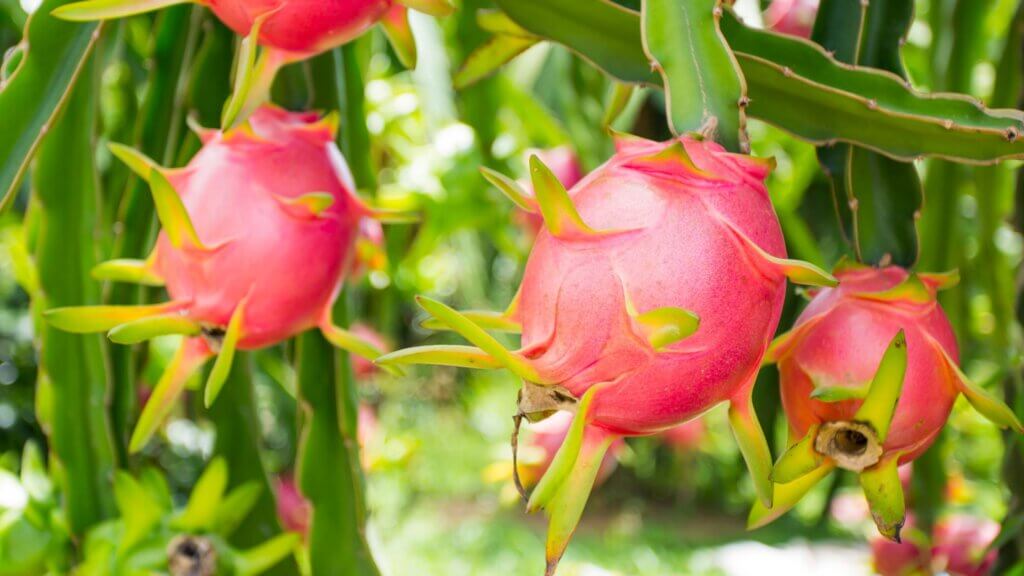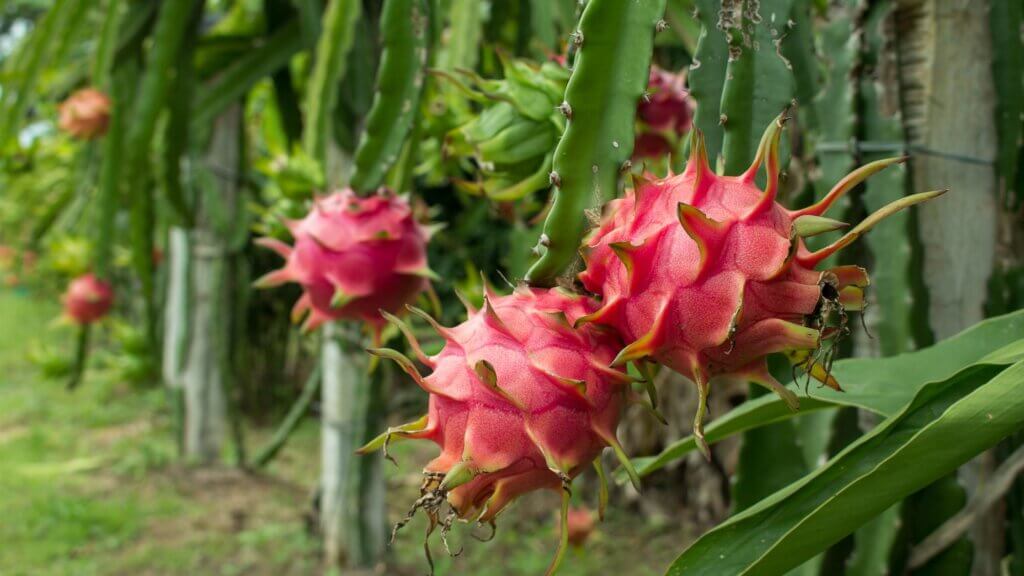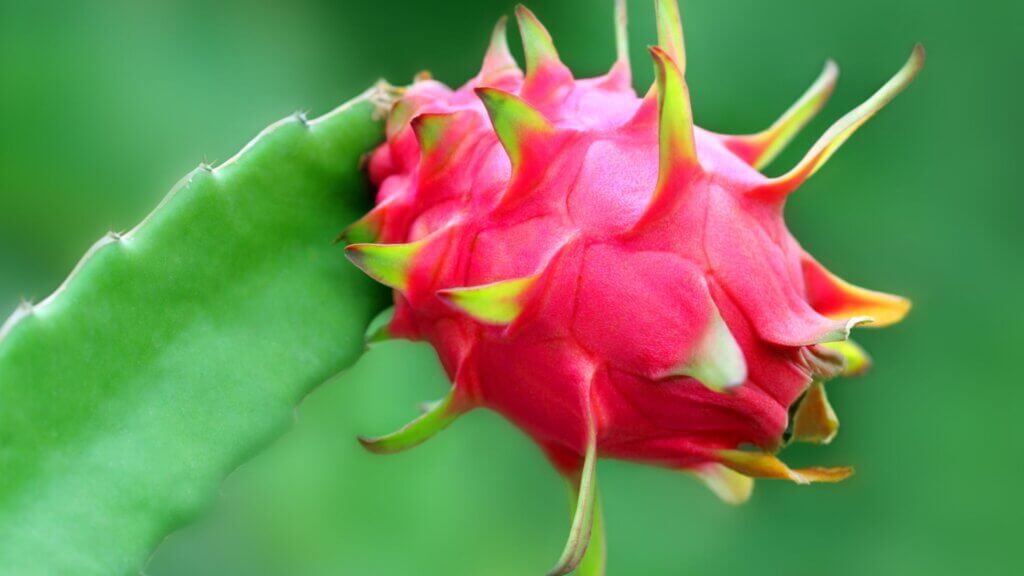Dragon fruit, also known as pitaya or pitahaya, is a tropical fruit that has gained popularity due to its vibrant colour, unique shape, and numerous health benefits. Native to Central America, it thrives in warm climates, making South Africa an ideal environment for growing this striking and delicious fruit. This guide will provide you with everything you need to know about growing dragon fruit.
⚠️ Invasive Species Warning: Hylocereus undatus (white-fleshed dragon fruit) is classified as a Category 2 invasive species in South Africa, meaning it poses a risk to local ecosystems and requires specific management practices. Only approved, non-invasive varieties should be planted. Before cultivating dragon fruit, check with the South African Department of Forestry, Fisheries and the Environment (DFFE) or your local conservation authorities for updated regulations. Responsible cultivation helps protect South Africa’s biodiversity while allowing gardeners to enjoy this unique fruit. For more information, visit the Invasive Species South Africa Database or your provincial environmental authority.
1. Introduction to Dragon Fruit
Dragon fruit belongs to the cactus family, Cactaceae, and it grows best in warm, arid regions. In South Africa, provinces such as Limpopo, Mpumalanga, and parts of KwaZulu-Natal offer the perfect climate for cultivating this exotic fruit. Dragon fruit can be grown throughout most of South Africa, but it won’t perform well in areas that experience severe cold or frost, as it is frost-sensitive and thrives in warmer, frost-free climates.
Dragon fruit cutting and seeds forsale in South Africa
Although various dragon fruit varieties are available in South Africa, their availability may sometimes be limited by seasonality or regional restrictions. It’s advisable to check with local nurseries or specialised suppliers when looking to source dragon fruit plants.
2. Ideal Growing Conditions for Dragon Fruit
Climate: Dragon fruit thrives in subtropical or tropical climates with temperatures ranging between 18°C and 30°C. It is frost-sensitive, so avoid planting in areas prone to freezing temperatures.
Sunlight: Full sunlight is essential for optimal growth. Choose a location that receives at least 6 to 8 hours of direct sunlight daily.
Soil: Dragon fruit prefers well-draining soil. A sandy or loamy soil mix is ideal, as it prevents waterlogging, which can cause root rot.
Watering: Despite being a cactus, dragon fruit requires consistent watering. Keep the soil moist but not waterlogged. Water the plant deeply once or twice a week, depending on the weather conditions.
3. How to Plant Dragon Fruit
Propagation: Dragon fruit can be grown from seeds or cuttings. However, using cuttings is recommended for faster results.
Using Cuttings:
- Obtain a healthy 30 cm cutting from a mature dragon fruit plant.
- Allow the cutting to dry for a few days to prevent rotting, then plant it about 5 cm deep into a pot or directly in the ground.
- Space each plant at least 3 to 5 metres apart to allow ample room for growth.
Using Seeds:
- Scoop out the seeds from a ripe dragon fruit and wash off the flesh.
- Plant the seeds in a well-draining potting mix and cover them lightly with soil.
- Keep the soil moist and place the container in a sunny location.
Support System: Dragon fruit plants are climbing cacti, so they require support as they grow. Install a sturdy trellis, pole, or fence to guide the plant upward.
Lorem ipsum dolor sit amet, consectetuer adipiscing elit, sed diam nonummy nibh euismod tincidunt ut laoreet dolore magna aliquam erat volutpat.

4. Caring for Your Dragon Fruit Plant
Fertilising: Apply a balanced fertiliser regularly during the growing season (spring and summer). Organic compost or manure can also provide additional nutrients. Avoid over-fertilising, as too much nitrogen can lead to excessive foliage growth at the expense of fruit production.
Pruning: Prune your dragon fruit regularly to remove dead or damaged branches. This encourages airflow and sunlight penetration, promoting better fruiting. Pruning also helps manage the plant’s size, preventing it from becoming too heavy for its support structure.
Pest Control: Dragon fruit is relatively resistant to pests, but it can occasionally be affected by aphids, mealybugs, or ants. Use organic pest control methods like neem oil to protect your plant. Slugs and snails can also be a problem on Dragon fruit. Here more garden pest information.
5. Harvesting Dragon Fruit
Dragon fruit plants typically start producing fruit within 1 to 2 years when grown from cuttings. The fruits are ready to harvest about 30 to 50 days after the plant flowers. Here’s how to tell if your dragon fruit is ripe:
- The skin changes from green to vibrant pink or red.
- The “wings” or flaps on the fruit start to wither and dry out.
- Gently press the fruit—if it yields slightly, it’s ready to pick.
Harvest the fruit by cutting it from the plant, leaving a small section of the stem attached.
6. Common Problems and Solutions When Growing Dragon Fruit.
- Root Rot: Overwatering or poor drainage can lead to root rot. Ensure the soil is well-draining and water the plant only when the top layer of soil feels dry.
- Lack of Fruit Production: This could be due to insufficient sunlight, poor pollination, or over-fertilising with nitrogen. Ensure the plant receives enough sunlight and avoid excessive fertiliser use.
- Pests: For aphids or mealybugs, use organic pesticides like neem oil or encourage natural predators like ladybugs. Here our pests and diseass article category.

Questions and Answers About How to Grow Dragon Fruit
How long does dragon fruit take to grow fruit?
Dragon fruit plants typically start producing fruit 1 to 2 years after being planted from cuttings. Seed-grown plants may take up to 5 years to bear fruit.
How do you grow dragon fruit in South Africa?
Dragon fruit grows best in South Africa’s warm, frost-free regions such as Limpopo, Mpumalanga, and parts of KwaZulu-Natal. It requires well-draining soil, consistent watering, and full sun. Support structures like trellises help the plant thrive as it climbs.
How do you grow dragon fruit at home?
To grow dragon fruit at home, plant it in well-draining soil in a sunny spot, and provide a sturdy trellis or pole for the plant to climb. Water regularly but avoid waterlogging, and apply a balanced fertiliser monthly during the growing season.
Is dragon fruit invasive in South Africa?
Dragon fruit is not considered invasive in South Africa. It is a cultivated species that requires care and attention to thrive and does not pose a threat to native plants.
Why is dragon fruit so expensive?
Dragon fruit is expensive due to the labour-intensive cultivation process, its seasonal availability, and the time it takes to bear fruit. Additionally, because it is often grown in specific regions, the cost of transport and storage can contribute to the price.
Does dragon fruit need a lot of sun?
Yes, dragon fruit requires plenty of sunlight—at least 6 to 8 hours of direct sun per day for optimal growth and fruit production.
What is the lifespan of a dragon fruit plant?
A well-cared-for dragon fruit plant can live and produce fruit for over 20 years, making it a long-term addition to your garden.
Is dragon fruit fast-growing?
Yes, dragon fruit is a relatively fast-growing plant, especially when grown from cuttings. It can grow up to 1.5 to 2 metres per year in ideal conditions.
How often do you water a dragon fruit plant?
Water your dragon fruit deeply once or twice a week, depending on the weather. Ensure the soil dries out slightly between waterings to avoid root rot.
How long does it take for dragon fruit to flower?
Dragon fruit plants typically flower in 6 to 8 months after planting. However, this depends on factors like the growing conditions and the age of the plant.
What triggers dragon fruit to flower?
Dragon fruit flowers are triggered by warm temperatures and long daylight hours, typically during late spring and summer. Adequate sunlight and proper care, such as consistent watering and fertilising, will encourage flowering.
Why does my dragon fruit flower but no fruit?
If your dragon fruit plant flowers but does not produce fruit, it may be due to insufficient pollination. Some dragon fruit varieties require cross-pollination, so hand-pollinating or planting a second variety nearby can help.
What fertilizer is best for dragon fruit?
A balanced fertiliser with an equal ratio of nitrogen, phosphorus, and potassium (NPK 10-10-10) is ideal for dragon fruit. Organic compost or well-rotted manure can also provide essential nutrients.
How do you make dragon fruit grow faster?
To encourage faster growth, ensure the plant gets plenty of sunlight, provide a well-draining soil mix rich in organic matter, and water it regularly without overwatering. Pruning and regular feeding with balanced fertilisers will also promote faster growth.
What do I feed dragon fruit?
Dragon fruit thrives on balanced fertilisers with an equal ratio of nitrogen, phosphorus, and potassium (NPK 10-10-10). You can also feed it with compost, well-rotted manure, or organic fertilisers to boost growth.
Is cow manure good for dragon fruit?
Yes, cow manure is a good organic fertiliser for dragon fruit, providing essential nutrients that support healthy growth. Be sure to use well-rotted manure to avoid burning the plant roots.
How to Grow Dragon Fruit in SOuth Africa Additional Resources
For more in-depth information on how to grow dragon fruit, check out these helpful resources:
GrowVeg – How to Grow Dragon Fruit
This guide provides useful tips on growing dragon fruit, including planting, care, and harvesting.South Africa Online – Dragon Fruit Farming
Learn more about the commercial farming of dragon fruit in South Africa and explore industry insights and practices.Seeds for Africa – Dragon Fruit Seed Package
Purchase rare dragon fruit seeds, including golden pitaya and other unique varieties, perfect for your garden.
These resources will provide further guidance and options for growing and sourcing dragon fruit in South Africa.


